One of the largest leaps a young advantage player (AP) makes early in his career is the realization that ordinary blackjack card counting is an essentially worthless pursuit. Seeing his first hole-card opens a panorama of potential income never before considered. The first question is if it’s legal; few advantage players want to cross the thin blue line into cheating. At the Golden Nugget Casino in Las Vegas on November 22, 1983, Steven Einbinder and Tonly Dalben were caught hole-carding, with Dalben signaling the hole card to Einbinder. The Supreme Court of the State of Nevada found that:
Dalben was lawfully seated at his position at the blackjack table, that he did not use any artificial device to aid his vision, and that he was able to see the dealer's hole card solely because of the admittedly sloppy play of the dealer. Respondent Dalben then communicated his information to respondent Einbinder. The district court ruled that respondents' conduct did not constitute a violation of the cheating statutes. We agree.
In Nevada, a team of APs can legally sit at a table game with one of the players viewing the hole-card and communicating the information to confederates at the table. Similar conclusions have been reached by courts in other gaming jurisdictions. There is no legal issue in a team approach to crushing a hole-carding opportunity. The casinos might not like it much, but it is no more against the law than eating an apple in a meadow with butterflies circling.
This leaves three problems for the hole-carding AP:
-
Determining the games are vulnerable to hole-carding, the edge and the hole-card strategy.
-
Finding a game with a hole-carding opportunity.
-
Slaughtering the game and getting the hell out of there.
Plenty has been written on hole-carding and blackjack. I read about it for the first time in Million Dollar Blackjack, by Ken Uston. Many other sources are available that contain useful information and strategies. Foremost among these (of course) is Beyond Counting, by James Grosjean. In my own experience, the most common blackjack hole-card read was paint/no-paint, that is, the ability to distinguish the cards Jack, Queen, King from the other cards. Grosjean refers to this as “PNP.” It is not a coincidence that PNP strategy is absent from Beyond Counting.
In this blog, I have focused on hole-carding proprietary games. The proprietary games that are vulnerable require that a strategic decision take place after the initial wager is made and the hidden cards have been dealt. Such a decision is typically to make a “Play” or “Raise” bet in an Ante-style game. Nearly all of the popular proprietary games have this type of structure. However, not all can be effectively beaten by hole-card play.
Vulnerable Games
Of the most popular proprietary games, the ones with the greatest potential for hole-card exploitation are Mississippi Stud Poker and Ultimate Texas Hold’em Poker. The reader may wonder why Three Card Poker is not in this premium list. Three Card Poker has long been the easiest opportunity to find. It also has the easiest hole-card strategy to master, by far. But in practice, Three Card Poker is very tough to beat, giving only a 3.48% edge to the AP under perfect conditions.
There are other games where an edge seems possible, but unless the hole-card exposure is extreme, no practical edge can be gained. Among games in this category are Caribbean Stud, Crazy 4 Poker, Pai Gow Poker and Four Card Poker, where multiple cards must be viewed to get an edge.
Here is a list of hole-card opportunities covered in this blog to date, along with the edge that can be obtained using perfect hole-card strategy:
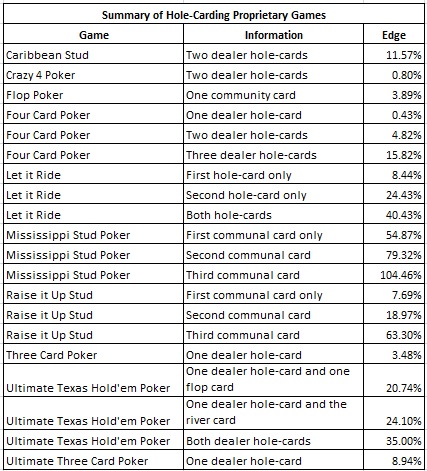
The reader will notice that the very common game Texas Hold’em Bonus Poker is absent from this list. I have not yet done the work to quantify the edge or strategy.
Opportunity
The question of opportunity usually comes down to the time intensive labor of scouting games. It used to be the case that good games could be delicately fleeced. However the competition among hole-carding teams has now made it standard policy to slaughter the best games. After a game is burned, it does not mean that a similar opportunity will not arise at the same casino. In the casino industry, hard lessons have a way of being forgotten.
There are four things that APs are looking for while pounding the pavement.
These are:
-
Poorly designed shufflers.
-
Poorly designed layouts.
-
Sloppy dealing procedure.
-
The ability to create an opportunity.
The Ace shuffler has a cradle that rests about three inches above the layout. It is nearly impossible to avoid exposing the hole-card using this shuffler, though with solid technique the exposure is unexploitable. I conjecture that it is for this reason, in part, that the Ace is no longer available from SHFL (formerly Shuffle Master). However, many casinos own their own Ace shufflers and continue to use them. Opportunities to play against the Ace shuffler persist worldwide. I discussed the Ace shuffler in this post.
The iDeal shuffler is a more reasonable and recent attempt to safeguard against hole-card play. With the ability to lift the cards to table level and no higher, the hole-card can be easily protected with correct procedure. However, the motion of the dealer’s hand is up and away from the table. Isaac Newton’s first law of motion is that an object in motion stays in motion until an external force acts on it. In other words, unless the dealer consciously stops the upward motion of his hand, his hole-card may be exposed. I discussed the iDeal shuffler in this post.
Table layouts should be designed by management to use these shufflers in the safest possible way. Foremost, these shufflers should be placed on top of the table (Ace shuffler), or inserted into a cutout in the table (iDeal shuffler). Furthermore, no obstacles should be placed in the way of the delivery of the cards from the shuffler to the table. Placing the shuffler at first base is the most natural position for the dealers, who are used to dealing from a shoe. By putting the discard tray on the third-base side, and all other signage, ash trays, drop box, etc., on the third-base side, the shufflers are much less likely to cause issues.
The following pictures show worst-case scenarios for the Ace shuffler:
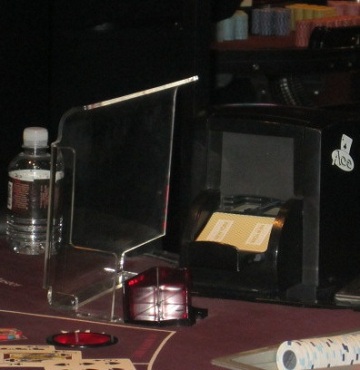
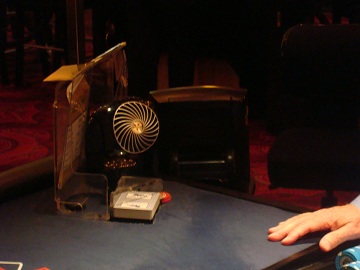
The following pictures show worst-case scenarios for the iDeal shuffler:
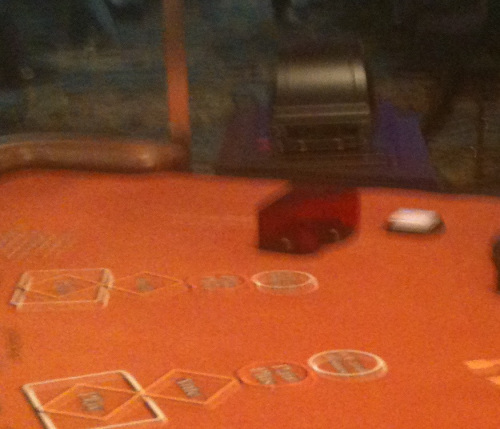
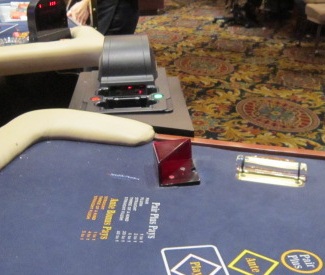
For the experienced scout, it takes just a moment to look at a dealer and determine that they are not a candidate for hole-card exposure. Most dealers deliver each and every packet with precaution and precision. After one hand, these dealers can be dismissed as unreadable.
There are some dealers who expose cards when dealing to the players, but when they deliver their own cards, they have faultless procedure. As a player, there were many times I would get excited on seeing the bottom card on packets dealt to players around the table, only to be brought down to earth by how the dealer dealt her own cards. Nevertheless, such a dealer may start exposing cards towards the end of her shift when she is tired. She may also be susceptible to a more proactive method where APs encourage the dealer to flash her hole-card using diversions and distractions.
Most dealers who expose their hole-card have a consistent but small procedural issue. They may grip the cards incorrectly. They may raise their cards too high. They may turn their wrist slightly. They may separate their cards slightly, exposing a corner or edge. Whatever the issue, it may afford the opportunity to catch a glimpse of that precious card. Most of the time, this view will be from the base opposite the placement of the shuffler. For example, with the shuffler at third base, the hole-card will be visible at first base. This is not a universal rule. Dealers find ways of exposing cards that violate every expectation for where a view should be.
APs have also discovered that even if a dealer is dealing flawlessly, in some cases they can manipulate either the dealer or table conditions to encourage a procedural breakdown that can lead to hole-card exposure. This can be accomplished through the physical position that wagers are placed on the table, by filling the rack with one dollar chips from the poker room, by the use of verbal distractions and by other manipulations. For example, by engaging the dealer in a subject they are passionate about, their attention may be drawn away from correct dealing procedure, giving the AP a better chance.
Put a weak or sloppy dealer in a casino that is using an unsafe shuffler on a table with a poorly designed layout on a game with a premium edge for hole-card play and a golden opportunity is at hand.
Getting Away with It
The final part of hole-carding proprietary games has to do with the art of getting away with it. The skilled hole-card player understands the delicate balance of optimal strategy, bet size and good cover. I was never good at either getting big money down or getting away with it, so I can speak more from failure than success here. In many cases, what I did was a model for what not to do. But I certainly knew some extraordinary players.
Hole-card play has its own idiosyncratic tells. An uninformed pit boss watching a player who is catching a hole-card will be watching a player who is, at times, significantly violating sensible strategy. The boss may think that the player is an idiot who is getting lucky, concluding that the player’s luck is sure to change soon. This type of scenario plays out every night in most casinos. That’s one of the stereotypes the hole-card player wants to embody: the lucky idiot.
The first step is to admit you don't know and ask the question. The usual answer is "I've been in the industry for xx years, so ..." Time does not, by itself, instill wisdom. Hence, from Shakespeare's King Lear, Act 1, scene 5:
Thou shouldst not have been old till thou hadst been wise.
I was therefore overjoyed to be asked the following question:
If an individual were to make the same wager every time on blackjack, but deviated from basic strategy according to the true count, could that person actually gain any significant edge?
The answer to the question that was actually asked is “no” if the game is played with two or more decks. My hunch was that the person who asked the question above was really asking about a player who was flat betting and making odd plays who was apparently gaining a significant edge. I smell hole-card play.
The hole-card player would rather not be noticed at all. But playing maximum bets holding 7, 2-offsuit in Mississippi Stud is going to be hard to do without being noticed. Likewise, it’s tough to fold an Ace in Three Card Poker if the cards for each hand are spread face up before being put in the discard tray.
The team will usually seat the heavy bettor as distant from the accessible information as possible. This can be accomplished by using the well-known “big-player” and “spotter” combination. The spotter’s job is to get the hole-card and relay the information to the big player. The big player’s job is to get big bets down while using the hole-card information signaled to him in an effective manner.
The spotter will typically play near the table minimum and try to blend in as much as possible. She will play the unbeatable side bets. She will play as if she does not know the hole-card information. She may arrive at the table well before the big player. She most likely will stick around after the big player leaves, to pick up any chatter about what just happened and to give distance to any questions of "relationship" between the players. She may be a young Asian woman, just barely 5-feet tall.
A strong team will have the resources to rotate in different big players and spotters, as needed, to maximize what they can take from the game. The game will soon be burned out by this team, but that doesn’t mean they want to be caught doing it.
A big part of successful hole-carding is knowing what to do in the dead time. It may be necessary for players to play on a game without the edge. They may be waiting for a certain dealer to arrive on the table. It may just be break time. It is therefore necessary that every team member have a solid understanding of basic strategy for the game being targeted. It comes as no surprise, therefore, that James Grosjean published basic strategy cards for many of the most popular novelty games
I was never a member of one of these large formal advantage play teams. But, in conversations with members of some of these teams, I did learn a bit about the sub-culture. It was darker than I could have imagined. The mystique of valiant slayers of casinos quickly gave way to stalkers, drug addicts and a gang mentality with turf wars and threats of violence. After my old website cardcounter.com was hacked by a member of the “Las Vegas Hole-Card Mafia,” I received the following email warning from a top Las Vegas hole-card player:
If I were you, I would get rid of the bulletin boards completely on your site … I wish it weren't so, but the advantage player underground is littered with psychopaths and miscreants.
Games are as likely to be burned out by competing teams as by the team that is first to spot the game. It’s a turf war, with multiple teams competing for the scarce resource of top games. Teams are no longer motivated to milk opportunities, understanding that another team is not far behind. It is not unusual for one team to burn a game just so members of another team are identified. A simple anonymous phone call to surveillance will do the trick: “There’s a dealer who is showing her hole-card on Ultimate, and the guys on seats 1 and 5 are working as a team against her.”
A fantastic book that describes the great big world of “getting away with it” is Advanced Tactics in Casino Advantage Play, by Abram Alexander. Get it. Read it.
Alexander wrote:
I have been told that, in days past, there existed an "us vs. them" mentality among advantage players, leading them to cooperate with each other, because they perceived the casinos as a common enemy. In such a climate, rivals would be easy to deal with, because they would almost certainly be open to cooperation and sharing. I can say that this is not the case anymore. There is no honor or agreement to be had among rivals anymore, and the competition can be quite fierce. Each team usually plays according to its own rules and interests; there are no industry standards for how to deal with other advantage players. Some rivalries are so bitter that they involve players ratting each other out to surveillance or the pit.
Conclusion
APs employ expert mathematicians and programmers to determine the edges and strategies. They relentlessly scout for vulnerable games. They are members of well-funded and highly organized teams that are ready to travel at a moment's notice.
Success is the meeting point of preparation and opportunity. With plenty of each, the current generation of APs are running the tables on the table games industry. It is time for the industry to wise up. Everything is broken. We’ve got a lot of work to do.


